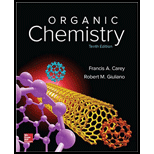
Interpretation:
The structural formula of the most stable cyclohexadienyl cation intermediate formed in each of the given reactions is to be written. Whether this carbocation is more or less stable than the cyclohexadienyl intermediate formed by benzene, is to be determined.
Concept Introduction:
Compounds containing benzene ring undergo electrophilic
The mechanism of electrophilic aromatic substitution involves two steps.
In the first step, an electrophile accepts an electron pair from pi system of benzene giving an intermediate called as cyclohexadienyl cation or arenium ion intermediate.
In the second step, the cyclohexadienyl cation intermediate undergoes deprotonation to restore the aromaticity of benzene ring.
In order to form cyclohexadienyl cation intermediate, the electrophile must be reactive.
Electron donating substituents present on the benzene ring increase the reactivity towards the electrophilic aromatic substitution reactions by stabilizing the cyclohexadienyl cation intermediate.
When an electron donating substituent is attached to the benzene ring, the cyclohexadienyl cation intermediate formed will be more stable than the cyclohexadienyl intermediate formed by benzene.
When an electron withdrawing substituent is attached to the benzene ring, the cyclohexadienyl cation intermediate formed will be less stable than the cyclohexadienyl intermediate formed by benzene.
Stability of a cyclohexadienyl cation intermediate depends mainly on two factors – its proximity to an electron donating or electron withdrawing group and whether it is an allylic carbocation or not.
Want to see the full answer?
Check out a sample textbook solution
Chapter 13 Solutions
ORGANIC CHEMISTRY (LL)-W/SOLN.>CUSTOM<
- Beer’s Law is A = εbc, where A is absorbance, ε is the molar absorptivity (which is specific to the compound and wavelength in the measurement), and c is concentration. The absorbance of a 2.31 × 10-5 M solution of a compound is 0.822 at a wavelength of 266 nm in a 1.00-cm cell. Calculate the molar absorptivity at 266 nm.arrow_forwardHow to calculate % of unknown solution using line of best fit y=0.1227x + 0.0292 (y=2.244)arrow_forwardGiven a 1,3-dicarbonyl compound, state the (condensed) formula of the compound obtaineda) if I add hydroxylamine (NH2OH) to give an isooxazole.b) if I add thiosemicarbazide (NH2-CO-NH-NH2) to give an isothiazole.arrow_forward
- Complete the following acid-base reactions and predict the direction of equilibrium for each. Justify your prediction by citing pK values for the acid and conjugate acid in each equilibrium. (a) (b) NHs (c) O₂N NH NH OH H₁PO₁arrow_forward23.34 Show how to convert each starting material into isobutylamine in good yield. ཅ ནད ཀྱི (b) Br OEt (c) (d) (e) (f) Harrow_forwardPlease help me Please use https://app.molview.com/ to draw this. I tried, but I couldn't figure out how to do it.arrow_forward
- Propose a synthesis of 1-butanamine from the following: (a) a chloroalkane of three carbons (b) a chloroalkane of four carbonsarrow_forwardSelect the stronger base from each pair of compounds. (a) H₂CNH₂ or EtzN (b) CI or NH2 NH2 (c) .Q or EtzN (d) or (e) N or (f) H or Harrow_forward4. Provide a clear arrow-pushing mechanism for each of the following reactions. Do not skip proton transfers, do not combine steps, and make sure your arrows are clear enough to be interpreted without ambiguity. a. 2. 1. LDA 3. H3O+ HOarrow_forward
- b. H3C CH3 H3O+ ✓ H OHarrow_forward2. Provide reagents/conditions to accomplish the following syntheses. More than one step is required in some cases. a. CH3arrow_forwardIdentify and provide an explanation that distinguishes a qualitative and quantitative chemical analysis. Provide examples.arrow_forward

 Organic ChemistryChemistryISBN:9781305580350Author:William H. Brown, Brent L. Iverson, Eric Anslyn, Christopher S. FootePublisher:Cengage Learning
Organic ChemistryChemistryISBN:9781305580350Author:William H. Brown, Brent L. Iverson, Eric Anslyn, Christopher S. FootePublisher:Cengage Learning Macroscale and Microscale Organic ExperimentsChemistryISBN:9781305577190Author:Kenneth L. Williamson, Katherine M. MastersPublisher:Brooks Cole
Macroscale and Microscale Organic ExperimentsChemistryISBN:9781305577190Author:Kenneth L. Williamson, Katherine M. MastersPublisher:Brooks Cole


